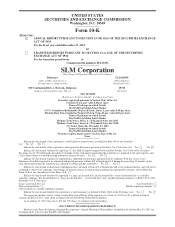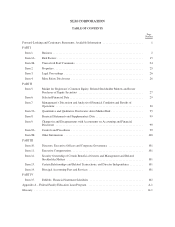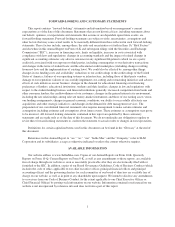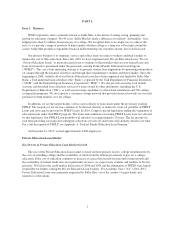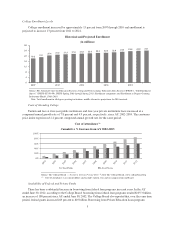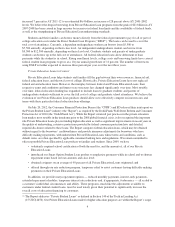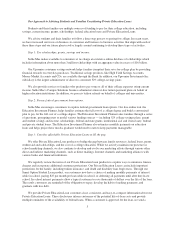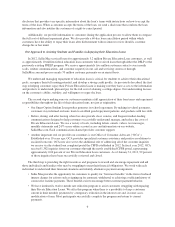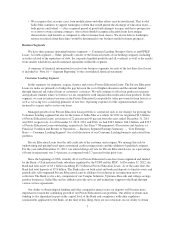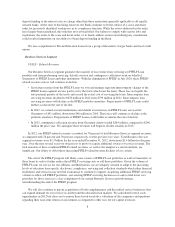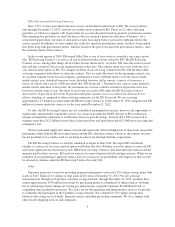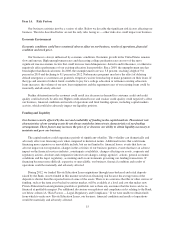Sallie Mae 2012 Annual Report Download - page 9
Download and view the complete annual report
Please find page 9 of the 2012 Sallie Mae annual report below. You can navigate through the pages in the report by either clicking on the pages listed below, or by using the keyword search tool below to find specific information within the annual report.• We recognize that, in some cases, loan modifications and other efforts may be insufficient. That is why
Sallie Mae continues to support bankruptcy reform that would permit the discharge of education loans —
both private and federal — after a required period of good faith attempts to repay and that is prospective
so as not to rewrite existing contracts. Any reform should recognize education loans have unique
characteristics and benefits as compared to other consumer loan classes. We do not believe bankruptcy
reform structured along these lines would be detrimental to our business model or future prospects.
Business Segments
We have three primary operating business segments — Consumer Lending, Business Services and FFELP
Loans. A fourth segment — Other, primarily consists of the financial results of our holding company, including
activities related to the repurchase of debt, the corporate liquidity portfolio and all overhead, as well as the results
from smaller wind-down and discontinued operations within this segment.
A summary of financial information for each of our business segments for each of the last three fiscal years
is included in “Note 16 — Segment Reporting” to the consolidated financial statements.
Consumer Lending Segment
In this segment, we originate, acquire, finance and service Private Education Loans. The Private Education
Loans we make are primarily to bridge the gap between the cost of higher education and the amount funded
through financial aid, federal loans or customers’ resources. We will continue to offer loan products to parents
and graduate students where we believe we are competitive with similar federal education loan products. In this
segment, we earn net interest income on the Private Education Loan portfolio (after provision for loan losses) as
well as servicing fees, consisting primarily of late fees. Operating expenses for this segment include costs
incurred to acquire and to service our loans.
Managed growth of our Private Education Loan portfolio is central not only to our strategy for growing the
Consumer Lending segment but also for the future of Sallie Mae as a whole. In 2012 we originated $3.3 billion
of Private Education Loans, an increase of 22 percent and 45 percent from the years ended December 31, 2011
and 2010, respectively. As of December 31, 2012, 2011 and 2010, we had $36.9 billion, $36.3 billion, and $35.7
of Private Education Loans outstanding, respectively. See Item 7 “Management’s Discussion and Analysis of
Financial Condition and Results of Operations — Business Segment Earnings Summary — ‘Core Earnings’
Basis — Consumer Lending Segment” for a full discussion of our Consumer Lending business and related loan
portfolio.
Private Education Loans bear the full credit risk of the customer and cosigner. We manage this risk by
underwriting and pricing based upon customized credit scoring criteria and the addition of qualified cosigners.
For the year ended December 31, 2012, our annual charge-off rate for Private Education Loans (as a percentage
of loans in repayment) was 3.4 percent, as compared with 3.7 percent for the prior year.
Since the beginning of 2006, virtually all of our Private Education Loans have been originated and funded
by the Bank, a Utah industrial bank subsidiary regulated by the UDFI and the FDIC. At December 31, 2012, the
Bank had total assets of $9.1 billion including $5.5 billion in Private Education Loans. As of the same date, the
Bank had total deposits of $7.8 billion. The Bank relies on both retail and brokered deposits to fund its assets and
periodically sells originated Private Education Loans to affiliates for inclusion in securitization trusts or
collection. The Bank is also a key component of our Campus Solutions, Upromise Rewards and college-savings
product businesses. Sallie Mae and its affiliates provide services and technology support to the Bank through
various service agreements.
Our ability to obtain deposit funding and offer competitive interest rates on deposits will become more
important to sustain the continuing growth of our Private Education Loan portfolio. Our ability to obtain such
funding is also dependent in part on the capital level of the Bank and compliance with other regulatory
requirements applicable to the Bank. At the time of this filing, there are no restrictions on our ability to obtain
7

